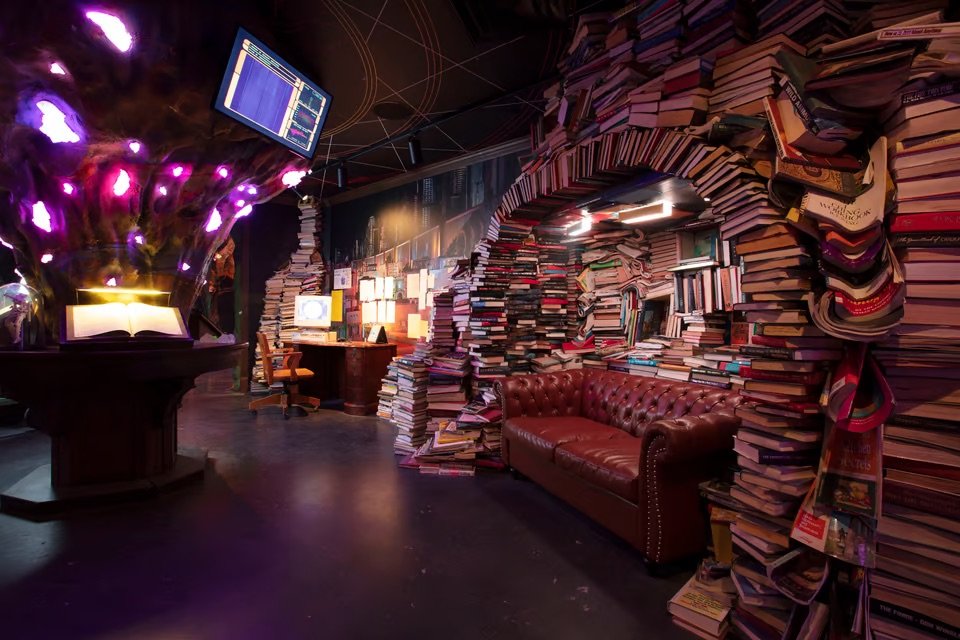Want to work as a writer for immersive projects? Here are some tips.
Meow Wolf's Convergence Station - the Ossuary Library, which was a hub of narrative for the exhibition. Photo by Kate Russell.
I recently put out an ask to connect with writers who sit in the sweet spot between gaming, AR/VR, and immersive. I was floored by the number of responses I got— literally hundreds. The job industry for creatives, particularly those who have been working in gaming/film/TV is scary right now. And there are a TON of super talented people looking for opportunities, particularly in the Wild West that is “immersive” because it is still growing. (Though we are also still figuring out what this industry is and how to make money in it).
I’ve had quite a few people ask me recently what I look for in a portfolio or in someone’s background when I’m hiring for an immersive project, so I want to give y’all some ideas.
To begin with, when I say “immersive,” I am often talking about projects that have a physical, built environment. I’ve developed creative for Meow Wolf, Submersive, Jon Favreau, F/X, and more, all with the goal of creating built environments and/or theatrical experiences that audiences can be physically immersed inside. (Disney, Universal, AREA15 and other permanent themed entertainment spaces fit in this category)
A big segment of immersive design roles right now are for brand activations and pop-ups: mini worlds the audience can enter and explore where they are hopefully wowed enough to take selfies, post on social media, and maybe even develop a deeper relationship with the brand and/or IP.
However, more and more, immersive can also refer to a fully digital immersive world. As Apple Vision Pro gains popularity (and someday lowers its price point), we’ll see more immersive experiences coming to mainstream audiences at home through a headset.
So where does this leave us as writers who might be coming to any of these categories from theater, film, TV, gaming, or themed entertainment? What skills or experience set you apart? What might a creative director, narrative director, or immersive showrunner be looking for?
Almost everything I work on starts in a writers room. The way I design immersive experiences is more akin to showrunning a TV show because a compelling immersive experience is usually a world– or worlds– with characters and stories. The stories might not play out in a linear fashion and the audience members might also be characters, but principles of good storytelling apply. Who are the characters? What do they want and why do we care? Do they get what they want? How do they connect with/challenge other characters? What makes this a world we do want to leave? What mysteries exist here?
I’m looking for writers who first and foremost understand how to write a damn good story. That means your stories and characters should jump off the page with just a brief introduction. Don’t send me a whole script; send me loglines or brief descriptions of the stories you’ve written or worlds you’ve created.
2. In the world of immersive, easily grokked, immediately compelling ideas rise above deep nuance. In immersive experiences, characters and stories can compete with gorgeous visuals. A good immersive writer in my book can also think visually and express visual concepts to collaborating artists so that story and characters ARE gorgeous visuals and vice versa.
I’m looking for writers who know how to work with visual artists and designers to create incredible, memorable characters. Send me visuals from your projects – photos, sketches, renderings, screenshots, and tell me how you contributed.
3. So much of immersive design is a combination of world building and user experience. Writers often function as the bridge between the Big Brilliant Idea and the “How Does the Audience Actually Interact (And Why Do They Want To)”? I often hire playwrights as immersive writers because they are generally good at thinking about how a concept will get experienced live, in physical space. I also appreciate video game writers for their ability to imagine a story getting doled out in clues, trailheads, and payoffs throughout a space and understanding what users pay attention to.
4. It’s one thing to have good ideas, but it’s another to be able to think about HOW that idea will reach the audience, how they will come to care about the character, how they will understand all of the story beats. This requires thinking about story spatially, in tandem with the environment, and understanding not just what makes a good story, but what makes a good story experience.
I’m looking for writers who are obsessed with the experience of the audience. It’s great if you can show how you’ve helped take concepts from idea to reality and how audiences responded.
5. Finally, as I said earlier, immersive writing often happens in collaboration, whether it's a writers room with other writers or in charrettes and project team meetings with other designers and creative directors. I need to know how you are in a brainstorm session. How do you usually contribute? What kind of ideas are your easiest to dream up? What’s your sweet spot? How precious are you with your ideas? How quickly can you spitball?
This is harder to show in a portfolio. I’d be impressed if you included a mind map that demonstrated how you brainstorm! Recommendations from other writers/collaborators go a long way. Tell me about a time you started with nothing and got to something brilliant.
There’s no rules to how you make a portfolio, particularly as a writer or narrative designer.
This is just my opinion, of course, but in recap, my suggestions are:
Offer short, compelling story loglines
Show amazing characters and worlds
Demonstrate how you think
Show how you collaborate
Prove how you’re thinking about the audience experience
This is my portfolio if it’s helpful to see! Questions? Anything I might have missed?
